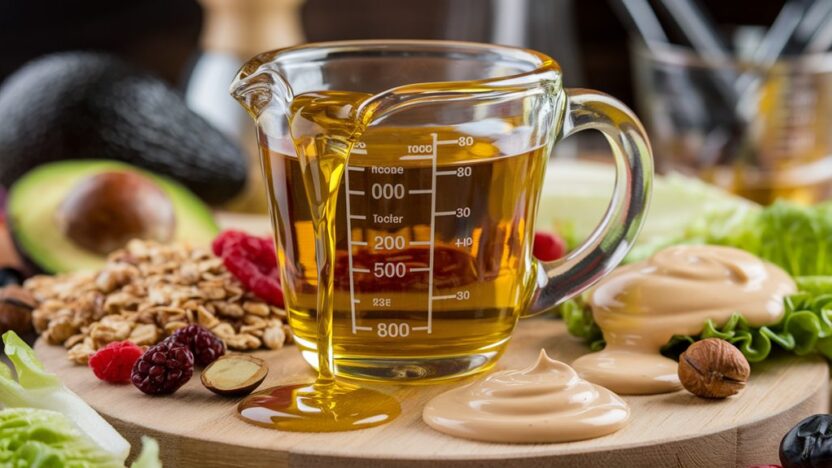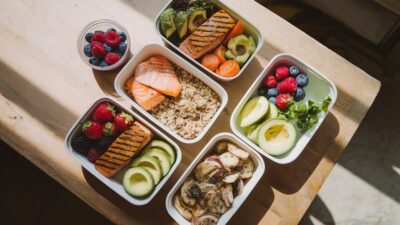Hidden calories can sneak into your diet in surprising ways, often adding hundreds of unexpected calories to your daily intake. You'll find them lurking in seemingly healthy smoothies, coffee drinks loaded with syrup and whipped cream, and energy drinks that can pack up to 250 calories per can. Restaurant meals hide extra calories through oversized portions, misleading menu descriptions, and calorie-dense cooking methods, while innocent-looking salad dressings can add 140-160 calories per serving. Even "healthy" foods like yogurt parfaits can become calorie bombs when topped with sweetened ingredients. Understanding these common culprits will help you make smarter choices and take control of your nutrition.
Sneaky Calories in Beverages
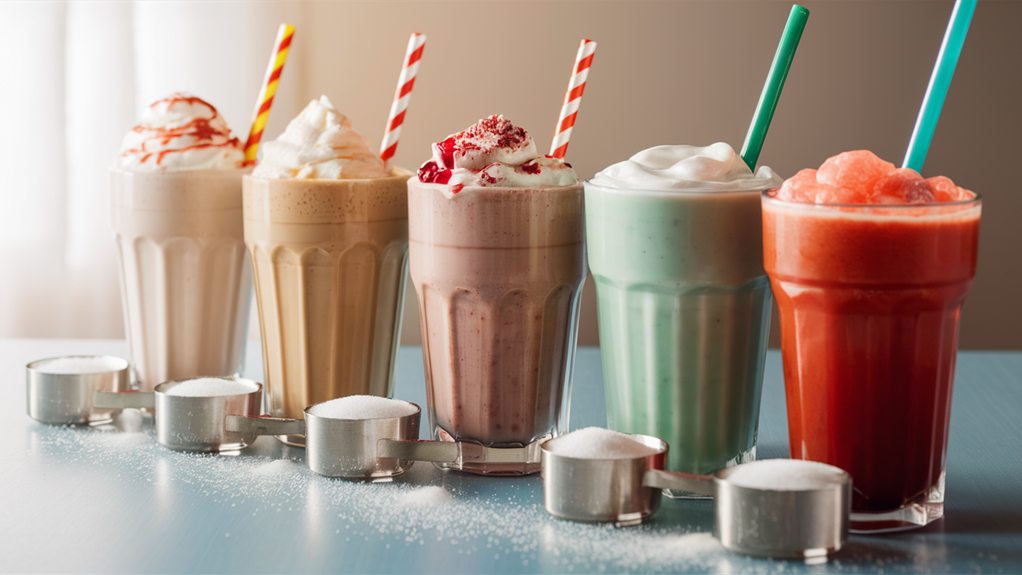
Liquid calories silently sabotage many people's diets. You might be surprised to learn that your favorite beverages can pack hundreds of hidden calories into your daily intake, often without making you feel full or satisfied.
Understanding energy balance is essential when it comes to managing these sneaky calories. From creamy lattes and smoothies to sports drinks and sodas, these hidden calories add up quickly throughout your day.
You'll find that seemingly healthy drinks can be major culprits, too. A 16-ounce fruit juice smoothie can contain up to 300 calories, while your morning coffee drink with whipped cream and flavored syrup might pack in 400 calories or more.
Even those popular energy drinks you're reaching for during afternoon slumps can hide 200-250 calories per can.
To outsmart these hidden calories, you'll want to check nutrition labels carefully and consider switching to lower-calorie alternatives. Water remains your best choice, but if you're craving something different, try unsweetened tea, black coffee, or sparkling water with a splash of natural fruit juice.
When you do indulge in caloric beverages, treat them as you'd dessert – something to enjoy occasionally rather than daily.
Sauces and Dressings
Along with beverages, sauces and dressings rank among the biggest sources of hidden calories in our diets. You might be surprised to learn that just two tablespoons of ranch dressing can add 140 calories to your salad, while the same amount of Caesar dressing packs around 160 calories. Many of these condiments contain hidden sugar and unhealthy fats that can quickly derail your healthy eating plans.
Incorporating healthier options, such as those rich in healthy fats, can help support your metabolism and improve satiety, making it easier to manage calorie intake.
When you're dining out, you'll want to pay special attention to pasta sauces, stir-fry sauces, and creamy dips that often come with appetizers. A single serving of Alfredo sauce can contribute up to 400 calories to your meal, while sweet and sour sauce, though lighter in calories, often contains significant amounts of hidden sugar.
Even seemingly healthy options like honey mustard dressing can pack 140 calories per serving.
You can make smarter choices by asking for dressings and sauces on the side, measuring your portions at home, or creating your own versions using ingredients like Greek yogurt, herbs, citrus juices, and vinegars. These alternatives will give you the flavor you're looking for without the excessive calories.
Restaurant Food Traps
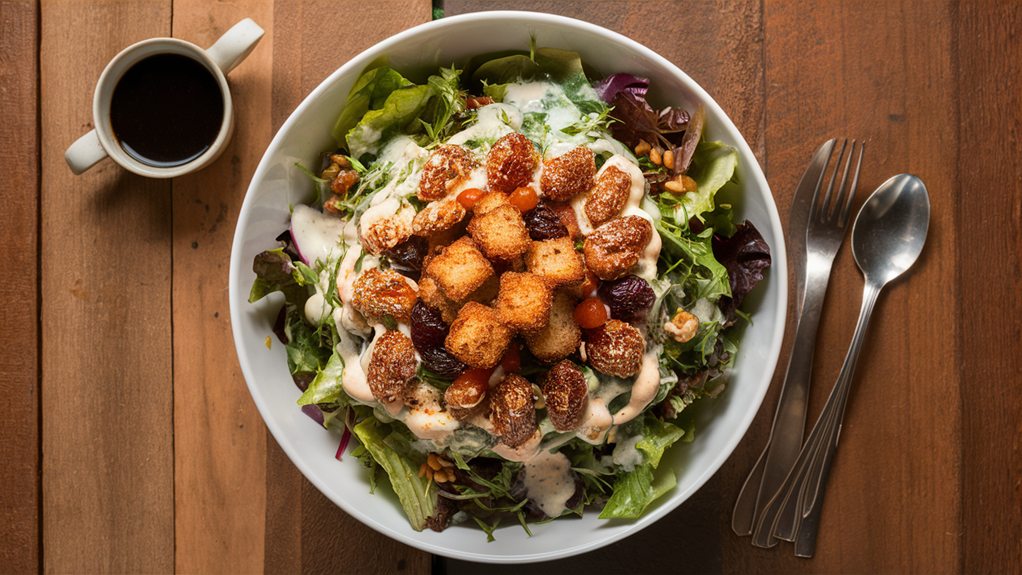
Three major traps await unsuspecting diners at restaurants: oversized portions, misleading menu descriptions, and calorie-dense preparation methods.
You'll often find that seemingly healthy dishes harbor unseen fats and extra calories through cooking techniques you wouldn't use at home. It's important to recognize that even dishes labeled as healthy can be deceptive, as many may contain hidden ingredients that contribute to their calorie count, as noted in unraveling common nutrition myths.
When you're dining out, watch for these common restaurant tricks that can sabotage your healthy eating goals:
- "Grilled" chicken that's actually been pre-soaked in oil to prevent sticking
- "Sautéed" vegetables that are swimming in butter or oil
- "Light" menu items that compensate for reduced fat with added sugars
- "Fresh" salads topped with fried garnishes and heavy dressings
You can protect yourself from these hidden calorie bombs by asking your server about preparation methods, requesting modifications, and being mindful of portion sizes.
Don't hesitate to box up half your meal before you start eating, as most restaurant portions are meant to serve two or more people.
Healthy Foods Gone Wrong
Many so-called healthy foods can actually derail your diet due to sneaky additives and preparation methods. You might think you're making smart choices, but even nutritious foods can become calorie bombs when they're dressed up with unnecessary ingredients.
To help avoid this, consider incorporating balanced meal plans that focus on proper portion sizes and nutrient-dense options.
Take salads, for instance. While fresh vegetables are naturally low in calories, the additions can turn your healthy choice into a dietary disaster. When you pile on croutons, cheese, nuts, and creamy sauces, you're adding hundreds of extra calories. A seemingly innocent Caesar salad can pack more calories than a burger.
Smoothies are another prime example of health food gone wrong. While fruit is nutritious, many commercial smoothies contain added sugars, honey, or sweetened yogurt that can triple the calorie count.
You'll also find this pattern with yogurt parfaits, where granola and sweetened fruit toppings transform a protein-rich snack into a dessert-like treat.
To keep these foods truly healthy, you'll need to watch portions and customize your orders. Ask for dressings and sauces on the side, limit high-calorie toppings, and always check ingredient lists when buying pre-made options.
Late Night Snacking Hazards
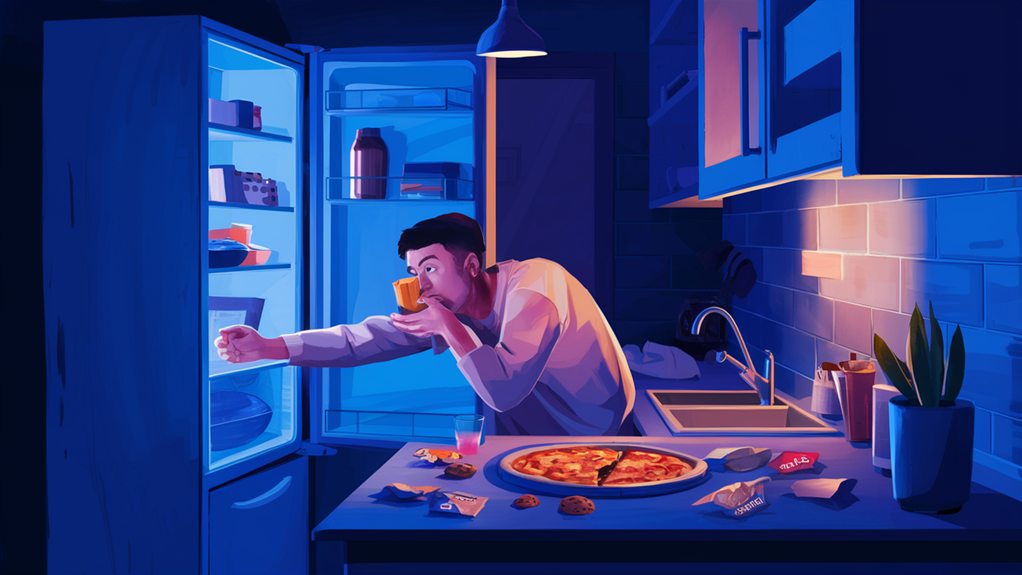
Late-night snacking represents one of the biggest obstacles to maintaining a healthy diet. When you're tired and hungry after a long day, you're more likely to reach for calorie-dense foods that can derail your nutritional goals. To combat this, consider employing strategies for controlling portion sizes, such as using smaller plates or practicing mindful eating.
Your body's natural rhythm isn't prepared to process heavy meals during the night, which means those extra calories are more likely to be stored as fat.
You'll often find yourself falling into these common late-night snacking traps:
- Mindlessly eating while watching TV or scrolling through your phone, losing track of portions
- Craving sugary or salty processed foods that give you a quick energy boost
- Choosing convenient, pre-packaged snacks instead of healthier alternatives
- Eating too close to bedtime, which can disrupt your sleep quality
To avoid these pitfalls, you'll need to create a cut-off time for eating, typically 2-3 hours before bed. If you're genuinely hungry, opt for light protein-rich snacks like a small handful of nuts or a piece of string cheese.
Portion Size Deceptions
Have you ever noticed how restaurant portions seem to grow larger every year? What used to be a standard serving size has now doubled or even tripled in many places, and you're probably consuming far more calories than you realize. This subtle increase in portion sizes has become so common that many people don't even recognize when they're overeating.
Additionally, the types of carbohydrates you choose can also influence your overall caloric intake and weight management; for instance, opting for whole grains and low-glycemic carbs can help stabilize blood sugar and control hunger.
Your plate at home might also be deceiving you. Those extra splashes of condiments, heaping spoonfuls of rice, or "just a little more" pasta can add hundreds of hidden calories to your meals. What you think is a normal portion often turns out to be two or three servings, especially with foods like cereal, nuts, and cooking oils.
Even healthy foods can contribute to weight gain when portions aren't controlled.
To avoid these portion size deceptions, try using smaller plates and measuring tools to serve your food. A proper portion of meat should be about the size of your palm, while a serving of rice or pasta should fit in your cupped hand.
Reading Labels Like a Pro
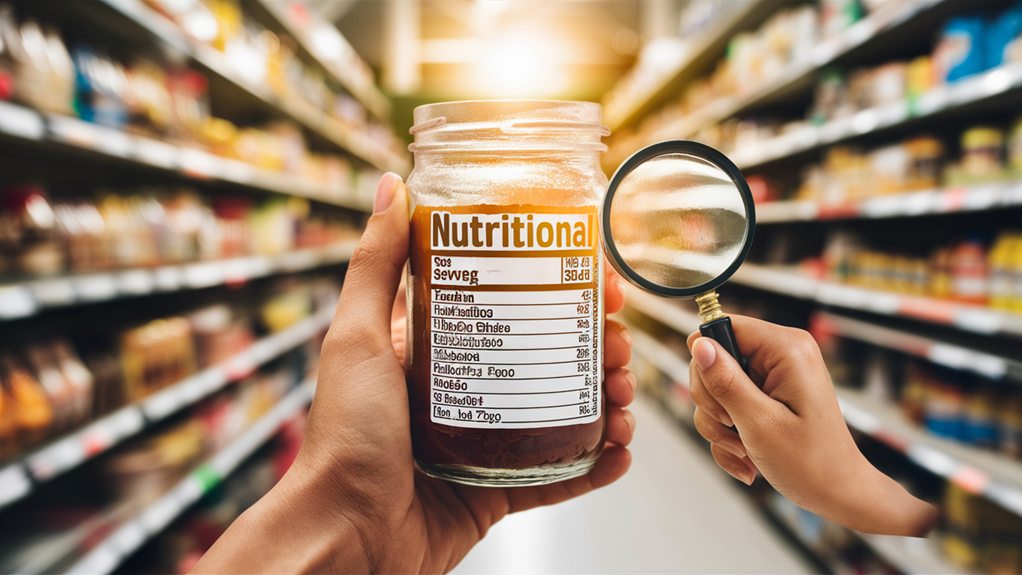
Beyond watching portion sizes, understanding food labels is your next line of defense against hidden calories. When you're shopping for packaged foods, you'll want to become a master at decoding nutrition facts panels, which isn't as complicated as it might seem at first glance.
Start by focusing on these key areas of any food label to make informed decisions:
- Serving size and servings per container, as many packages contain multiple servings
- Total calories per serving, which you'll need to multiply if you eat more than one serving
- Sugar content, including both natural and added sugars, which can quickly add up
- Ingredient list order, since ingredients are listed by weight from highest to lowest
You'll find that once you're comfortable reading labels, it becomes second nature.
Don't let yourself get overwhelmed by all the numbers and percentages; instead, focus on the information that matters most to your health goals.
Compare similar products side by side, and you'll start noticing patterns in how manufacturers present their nutrition information. This knowledge will help you make better choices and avoid unnecessary hidden calories.
